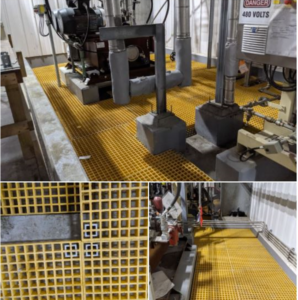Introduction to Industrial Fiberglass Grating
Industrial fiberglass grating is a robust material designed for numerous applications across various industries. Its unique properties, including high strength, resistance to corrosion, and excellent durability, make it an ideal choice for environments that demand safety and efficiency. This article explores the integral role of fiberglass grating in enhancing workplace safety and operational efficiency.

industrial fiberglass grating
The Basics of Fiberglass Grating
What is Fiberglass Grating?
Fiberglass grating is a composite material made from fiberglass strands bonded together with resins. This fabrication process creates a strong, lightweight, and durable platform that is used in various industrial applications.
Benefits of Using Fiberglass Grating in Industry
Fiberglass grating offers several advantages over traditional materials like steel. These include enhanced safety due to its non-slip surface, resistance to rust and corrosion, minimal maintenance requirements, and significant longevity. These features not only improve workplace safety but also reduce long-term costs.
Key Industries Benefiting from Fiberglass Grating
Energy Sector Applications
In the energy sector, fiberglass grating is used for walkways, platforms, and staircases in power plants, especially where moisture and corrosive materials are present.
Transportation Infrastructure
Fiberglass grating supports safety and durability in transportation infrastructure, providing reliable platforms and walkways in airports, railway stations, and bridges.
Oil and Gas Industry Uses
The oil and gas industry utilizes fiberglass grating extensively to ensure safety in corrosive environments where traditional metal structures would deteriorate quickly.
Marine Applications
Fiberglass grating is crucial in marine applications, resisting the harsh salty environment while providing stable surfaces on docks, vessels, and offshore platforms.
Technical Specifications and Types
Types of Fiberglass Grating
There are several types of fiberglass grating available, including molded and pultruded grating, each suited to different load-bearing and aesthetic requirements.
Key Properties of Fiberglass Grating
Physical Properties
Fiberglass grating is known for its high strength-to-weight ratio and its ability to withstand heavy loads without permanent deformation.
Chemical Resistance
The material’s resistance to a wide range of chemicals makes it suitable for chemical plants and refineries.
Load-Bearing Capacity
It is designed to bear substantial loads, making it ideal for heavy-duty industrial applications.
Installation and Maintenance
Installation Tips
Installing fiberglass grating involves measuring the area accurately, cutting the material to size, and securing it properly to prevent shifting.
Maintenance Guidelines
Maintenance of fiberglass grating is minimal, typically requiring only regular inspections and occasional cleaning to maintain its integrity and safety features.
Safety Features of Fiberglass Grating
Enhancing Workplace Safety
The non-conductive and non-slip surface of fiberglass grating helps prevent workplace accidents, contributing to a safer work environment.
Compliance with Industry Safety Standards
Fiberglass grating meets various safety standards, ensuring compliance across industries, which is critical for maintaining safety and avoiding regulatory issues.
Cost Analysis
Initial Cost vs Long-term Savings
While the initial cost of fiberglass grating can be higher than traditional materials, the long-term savings from reduced maintenance and replacement costs provide a significant return on investment.
Comparison with Other Materials
When compared to materials like steel, fiberglass grating offers a longer lifespan and better resistance to environmental factors, making it a cost-effective solution over time.
Environmental Impact
Sustainability Factors
Fiberglass grating is favored for its environmental benefits, including lower energy consumption during production and its long lifespan, which reduces waste.
Recycling and Disposal
The recyclability of fiberglass materials adds to its environmental appeal, allowing for easier disposal and less impact on landfills.
Innovations in Fiberglass Grating Technology
Recent Developments
Recent innovations in manufacturing and material science have enhanced the properties of fiberglass grating, making it more versatile and effective.
Future Trends in Fiberglass Materials
The industry is moving towards even more sustainable and efficient materials, with advancements in recycling processes and the development of new composites.
Case Studies
Real-World Applications and Benefits
Various industries have documented significant improvements in safety and efficiency after integrating fiberglass grating into their operations.
Challenges and Solutions
While the benefits are substantial, some challenges persist, such as the need for specialized installation techniques. However, solutions are continually being developed to simplify these processes.
Buying Guide
Choosing the Right Fiberglass Grating
Selecting the right type of fiberglass grating involves considering the specific needs of your application, including load capacity, environmental conditions, and aesthetic preferences.
Vendor Selection Criteria
Choosing a reliable vendor is crucial, like Unicomposite. Factors to consider include product quality, customer service, and the vendor’s ability to provide customized solutions.
Conclusion
Industrial fiberglass grating offers unparalleled benefits in terms of safety, cost-efficiency, and environmental impact. Selecting the appropriate type and ensuring proper installation are key to maximizing these benefits.




























